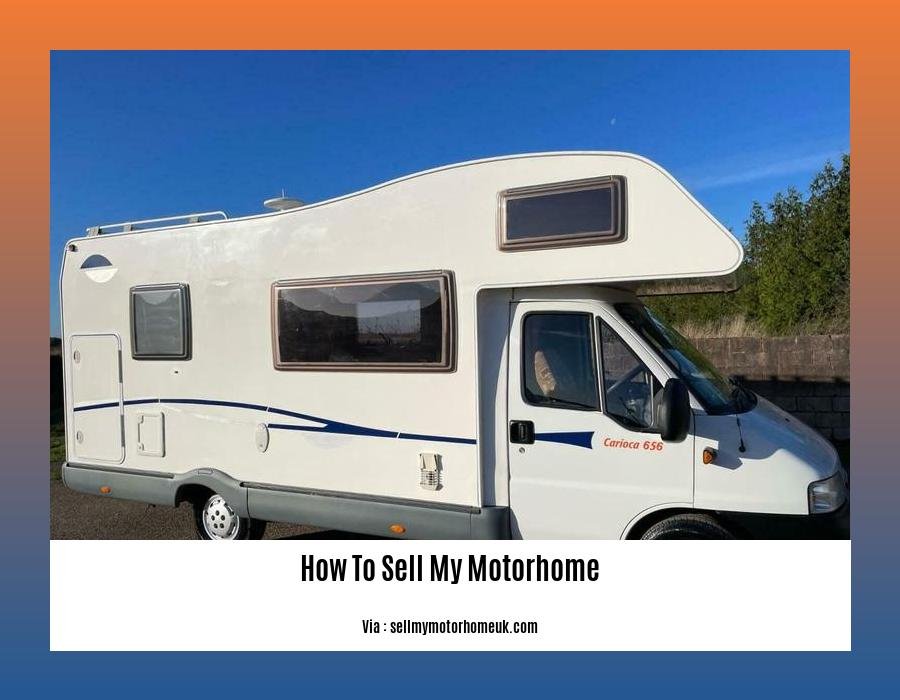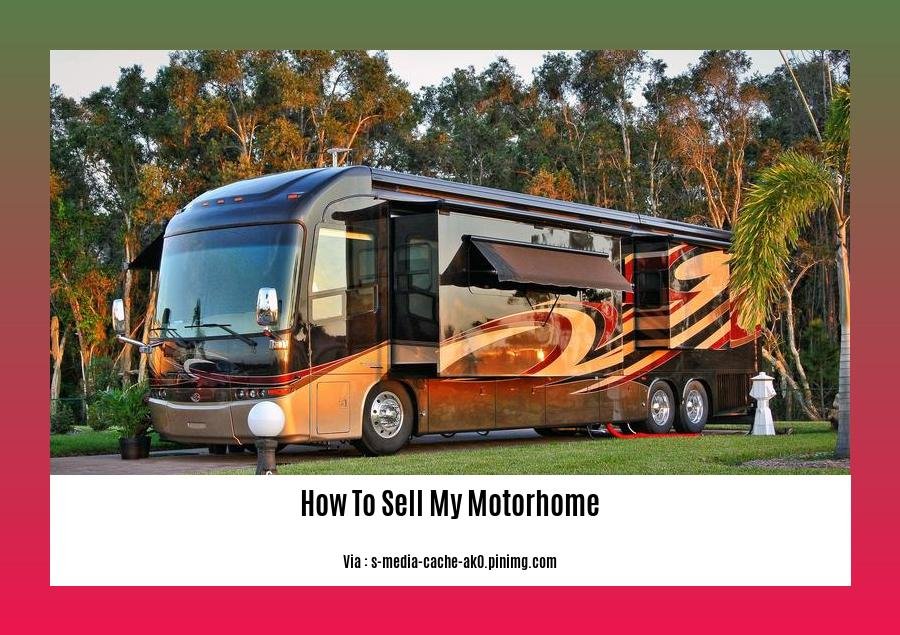In the world of recreational vehicles, the decision to sell a motorhome can be a significant and often lucrative endeavor. Whether you’re upgrading to a newer model, downsizing your nomadic lifestyle, or simply parting ways with your beloved RV, embarking on this journey requires careful planning, effective marketing, and skillful negotiation. In this comprehensive guide, [How to Sell My Motorhome: A Comprehensive Guide for Profitable Transactions], we’ll navigate the intricacies of selling a motorhome, unlocking the secrets to a successful and profitable transaction.
Key Takeaways:
-
Dealership: Part exchange or outright sale, broker: sale or return basis, privately: online or physical advertising.
-
Preparation: Wash, wax, and clean motorhome, ensure water and waste outlets function properly, gather keys and documents.
-
Pricing: Research market for fair price, consider mileage, condition, upgrades.
-
Advertising: Create online listing with detailed info and high-quality photos, place physical ads or utilize social media.
-
Viewings: Schedule in daylight, answer questions, provide test drive, maintain clean interior/exterior.
-
Negotiation: Be prepared to negotiate, consider reasonable offers.
-
Finalize: Complete paperwork, transfer ownership, receive payment, ensure satisfaction.
How to Sell My Motorhome: A Comprehensive Guide to Profitable Transactions

Welcome intrepid nomads and RV adventurers! Have you decided to embark on a new journey and sell your beloved motorhome? Whether you’re upgrading to a bigger rig or simply ready for a change, selling your motorhome can be a smooth and profitable process if you follow a strategic approach.
Step 1: Laying the Foundation for a Successful Sale
- Choose Your Sales Method Wisely:
- Dealership: Weigh the convenience of trading in or selling directly to a dealership against potentially lower returns.
- Broker: Consider selling your motorhome on a sale or return basis through a broker for wider reach and expertise.
-
Private Sale: Explore selling your motorhome privately through online platforms or local classifieds to maximize control and negotiation power.
-
Prepare Your Motorhome to Shine:
- Give your motorhome a thorough makeover, inside and out. Wash, wax, and clean every nook and cranny to make it look its best.
- Ensure all appliances, plumbing, and electrical systems are functioning properly.
- Gather all relevant documentation, including maintenance records, ownership papers, and manuals.
Step 2: Price it Right for a Quick Sale
- Research the Market:
- Study comparable motorhomes’ prices in your area to determine a fair market value.
-
Consider factors like your motorhome’s age, mileage, condition, and any unique features or upgrades.
-
Set a Competitive Price:
- Price your motorhome competitively to attract potential buyers while leaving room for negotiation.
- Be open to adjusting your price if necessary based on market conditions and buyer interest.
Step 3: Market Your Motorhome to the Right Audience
- Create an Enticing Online Listing:
- Craft a descriptive and engaging online listing that highlights your motorhome’s best features.
- Include high-quality photos from various angles and detailed information about its amenities.
-
Optimize your listing for search engines using relevant keywords.
-
Spread the Word:
- Advertise your motorhome on popular RV websites, online marketplaces, and social media platforms.
- Consider placing ads in local newspapers or magazines catering to RV enthusiasts.
- Leverage your personal network and let friends, family, and fellow RV owners know you’re selling.
Step 4: Prepare for Viewings and Negotiations
- Schedule Viewings Strategically:
- Arrange viewings during daylight hours when potential buyers can fully appreciate your motorhome’s features.
-
Be flexible with your schedule to accommodate serious buyers’ requests.
-
Make a Great First Impression:
- Maintain a neat and clean interior and exterior. Address any minor repairs or cosmetic issues.
- Be prepared to answer questions about your motorhome’s history, maintenance, and unique features.
-
Offer potential buyers a test drive to experience the motorhome firsthand.
-
Negotiate with Confidence:
- Be prepared to negotiate the price, but avoid dropping it too low.
- Consider reasonable offers and be willing to compromise to reach a mutually beneficial agreement.
Step 5: Finalize the Sale and Secure Payment
- Finalize the Paperwork:
- Once you’ve agreed on a price, prepare and sign the necessary paperwork, including the bill of sale, title transfer, and any other relevant documents.
-
Ensure both parties are satisfied with the terms of the sale before signing.
-
Secure Payment:
- Determine your preferred payment method (cash, check, or wire transfer) and ensure you receive the full amount agreed upon.
-
If using a check, verify it clears before releasing the motorhome to the buyer.
-
Complete the Sale and Say Farewell:
- Hand over the keys, manuals, and all relevant documentation to the new owner.
- Thank the buyer for their purchase and wish them happy trails in their new RV adventure.
Now that you have the knowledge and strategies to sell your motorhome successfully, it’s time to embark on this exciting new chapter. Remember to stay organized, patient, and flexible throughout the process. With the right approach and a bit of luck, you’ll soon find the perfect buyer for your beloved motorhome.
-
Thinking of selling your manufactured home? Then read how to sell your manufactured home guide. It’s jam-packed with tips.
-
If you want to make a profitable business out of selling mobile homes, click on how to sell my mobile home guide.
-
Looking for a comprehensive guide on how to set up a mobile home? Look no further, check out how to set up a mobile home article.
-
Turn your love for cars into a profitable business with our guide on how to start a used car business from home.
Market your motorhome to potential buyers

Imagine you’re at your favorite campsite, where the campfire crackles, and the stars twinkle above, and you’re ready to pass on the freedom and adventure of RV life to someone new. Selling your RV can be a rewarding experience, but it requires careful preparation and a strategic approach to attract potential buyers. Let’s dive into some insider tips that will help you market your motorhome and maximize your chances of a successful sale.
1. Create a Stellar Online Presence:
- Craft an eye-catching title that entices readers to click on your listing.
- Write a compelling description that paints a vivid picture of your motorhome’s features and benefits. Use descriptive language that makes the reader feel like they’re already on their dream RV adventure.
- Include high-quality photos that showcase your motorhome’s interior and exterior. Make sure the photos are well-lit and highlight its unique features.
- Consider creating a video tour of your motorhome that allows potential buyers to experience it virtually.
2. Price it Right:
- Research the market to determine a fair price for your motorhome. Consider factors such as the make, model, year, condition, and mileage.
- Be realistic with your pricing. Overpricing can deter potential buyers, while underpricing may leave you feeling shortchanged.
3. Spread the Word:
- List your motorhome on reputable RV sales websites and online marketplaces.
- Utilize social media platforms like Facebook, Twitter, and Instagram to share photos and details about your motorhome.
- Attend local RV shows and events to connect with potential buyers and showcase your vehicle.
- Consider using print advertising in RV magazines and newspapers to reach a wider audience.
4. Prepare for Viewings:
- Keep your motorhome clean and well-maintained. A clean and tidy RV makes a great first impression on potential buyers.
- Fix any minor issues or repairs before listing your motorhome for sale.
- Gather all relevant documents, such as the title, registration, maintenance records, and any warranties.
5. Build Rapport with Buyers:
- Be friendly and welcoming when interacting with potential buyers. Building a rapport can make the sales process smoother and more enjoyable.
- Be honest and transparent about the condition of your motorhome. Honesty builds trust and shows potential buyers that they can rely on you.
- Encourage in-person viewings so buyers can experience the motorhome firsthand and ask questions.
6. Negotiate Skillfully:
- Be prepared to negotiate the price, but don’t be afraid to stand firm on your bottom line.
- Be willing to compromise, but avoid dropping the price too low. Remember, your motorhome is a valuable asset.
- If you’re working with a broker or dealer, make sure you understand their fees and commissions before finalizing the sale.
7. Finalize the Sale:
- Once you’ve reached an agreement with the buyer, prepare the necessary paperwork, including the bill of sale and title transfer.
- Secure payment in full before releasing the motorhome to the buyer.
- Complete the sale by handing over the keys, documentation, and any other relevant items to the buyer.
Key Takeaways:
- Create a compelling online presence with a catchy title, detailed description, high-quality photos, and a video tour.
- Price your motorhome competitively based on market research.
- Promote your motorhome on reputable RV sales websites, social media, and at local events.
- Prepare your motorhome for viewings by cleaning, fixing issues, and gathering documents.
- Build rapport with potential buyers by being friendly, honest, and encouraging in-person viewings.
- Negotiate skillfully and be prepared to compromise, but don’t undervalue your motorhome.
- Finalize the sale by preparing paperwork, securing payment, and handing over the motorhome to the buyer.
Sources:
- How to Sell Your RV
- The Ultimate Guide to Selling Your Motorhome
Negotiate the Sale of Your Motorhome
Key Takeaways:
- Research: Know the market value, compare prices, and set a negotiable asking price.
- Presentation: Make your RV appealing with repairs, cleaning, and a detailed online listing.
- Marketing: Utilize RV websites, marketplaces, and social media to reach more buyers.
- Negotiation: Be confident, prepared, and willing to compromise to reach a deal.
- Documentation: Have all paperwork ready to finalize the sale smoothly.
The art of negotiating the sale of your motorhome requires finesse, market knowledge, and a strategic approach. Follow these steps to maximize your profit and ensure a successful transaction:
-
Do Your Homework:
-
Research recent sales prices of similar RVs in your area.
- Consider the condition of your RV, any upgrades or renovations, and mileage.
-
Set a fair asking price that leaves room for negotiation.
-
Prepare Your RV for Sale:
-
Address any mechanical issues, repairs, or maintenance needs.
- Deep clean the interior and exterior of the RV, including appliances and upholstery.
-
Make minor cosmetic improvements like touch-up paint or replacing old fixtures.
-
Create an Enticing Online Listing:
-
Take high-quality photos of your RV, showcasing its features and condition.
- Write a detailed description highlighting the unique selling points of your RV.
-
List your RV on reputable RV websites, marketplaces, and social media platforms.
-
Negotiate with Confidence:
-
Be friendly and establish trust with potential buyers.
- Be prepared to answer questions and offer test drives.
- Be negotiable on price, but avoid dropping it too low.
-
Use negotiation tactics like anchoring (starting with a higher price) and concessions (offering extras).
-
Finalize the Paperwork:
-
Have all necessary paperwork ready, including the title, bill of sale, and any lien releases.
- Review the sales contract carefully, ensuring all agreed-upon terms are included.
-
Secure payment before releasing the RV to the buyer.
-
Complete the Sale:
-
Hand over the keys, documentation, and any maintenance records to the buyer.
- Complete any remaining paperwork, such as title transfer and insurance cancellation.
- Say farewell to your RV and embrace the new chapter in your nomadic journey.
Remember, negotiating the sale of your motorhome is a process that requires patience, flexibility, and a willingness to compromise. By following these steps and maintaining a positive attitude, you can achieve a successful transaction that benefits both you and the buyer.
Source:
– How to Sell Your RV: A Step-by-Step Guide
– The Ultimate Guide to Selling Your RV
Finalize the Sale and Transfer Ownership
Closing the deal and transferring ownership of your motorhome might appear daunting, but it’s merely a matter of following a systematic process. Let’s break it down into three crucial steps to ensure a seamless transaction:
1. Prepare the Paperwork:
Before you meet the buyer, ensure you have all the necessary paperwork in order. These typically include:
- Vehicle Title: The official document proving ownership of the motorhome.
- Bill of Sale: A legal document outlining the sale and purchase agreement.
- Odometer Disclosure Statement: A declaration of the motorhome’s mileage.
- Lien Release (if applicable): If you have a loan on the motorhome, you’ll need a lien release from your lender before transferring ownership.
2. Finalize the Payment:
Secure the payment from the buyer in full before releasing the motorhome. Cash or a cashier’s check are commonly accepted forms of payment, but you can also explore other options like wire transfer or personal checks (though they may require a clearance period).
3. Transfer the Title:
Transferring the title to the new owner is a legal requirement. Visit your local Department of Motor Vehicles (DMV) with the buyer, and they’ll guide you through the process. Make sure you have the following documents:
- Original Vehicle Title: The physical title document, not a copy.
- Bill of Sale: The signed bill of sale.
- Application for Title Transfer: Usually provided by the DMV.
- Fees: The DMV charges a fee for transferring the title, which varies by state.
- Insurance: The buyer will need to provide proof of insurance before the title can be transferred.
Key Takeaways:
-
Prepare all necessary paperwork, including the vehicle title, bill of sale, odometer disclosure statement, and lien release (if applicable).
-
Finalize the payment in full, either through cash, cashier’s check, wire transfer, or personal check (subject to clearance period).
-
Transfer the title to the new owner at the local Department of Motor Vehicles (DMV), presenting the required documents and paying the transfer fee.
-
Ensure the buyer has proof of insurance before completing the title transfer.
-
RV Seller’s Checklist: How to Sell Your RV
-
Selling Your RV: A Step-by-Step Guide
FAQ
Q1: What are the main things to consider when selling a motorhome?
A1: When selling a motorhome, key considerations include the time of year, the condition of the vehicle, determining a competitive price, and ensuring proper preparation for viewings and negotiations.
Q2: How can I determine a fair selling price for my motorhome?
A2: To set a competitive price, research the market value of similar motorhomes in your area, taking into account factors such as mileage, condition, and any upgrades or modifications.
Q3: What are effective methods for advertising my motorhome for sale?
A3: Effective advertising strategies include creating an attractive online listing with detailed information and high-quality photos, placing ads in relevant publications or local classifieds, and utilizing social media to reach a wider audience.
Q4: How can I prepare my motorhome for viewings to attract potential buyers?
A4: Preparing your motorhome for viewings involves cleaning and detailing the interior and exterior, ensuring all water and waste outlets are functioning properly, emptying all tanks, and gathering all keys and documents related to the vehicle.
Q5: What paperwork is typically required to complete the sale of a motorhome?
A5: The necessary paperwork typically includes the title to the motorhome, a bill of sale, a vehicle history report, and any other documentation required by your local laws or regulations.
- White Kitchen With Butcher Block Countertops: A Warm, Inviting Design - January 4, 2026
- Marble Countertops Prices: What Impacts the Overall Cost to Install? - January 3, 2026
- Marble Countertops Cost: What Factors Impact the Total Price? - January 2, 2026










